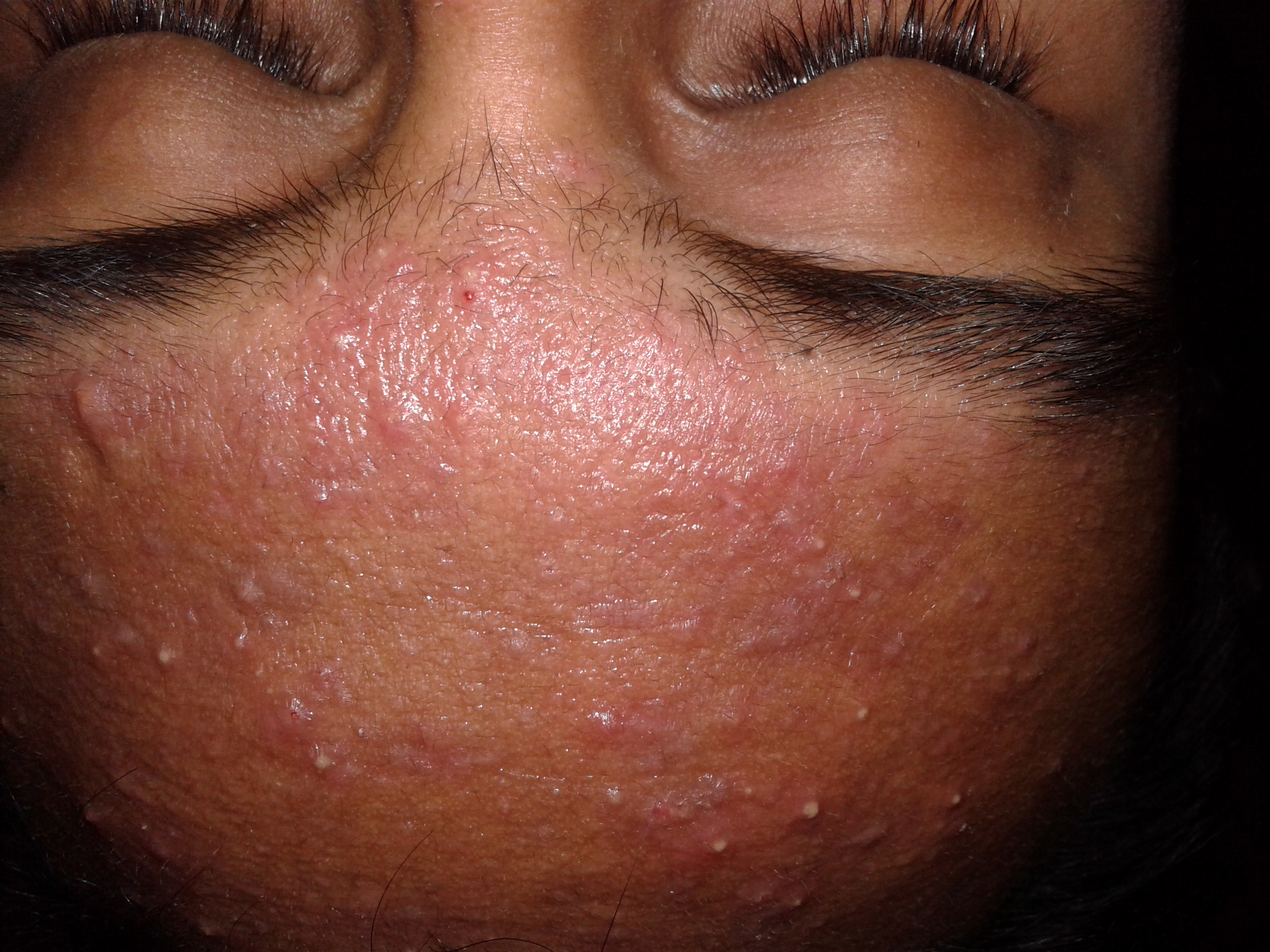
Image: "Acne vulgaris on a very oily skin" is licensed under CC BY-SA 4.0.
Acne Vulgaris
Introduction
Acne vulgaris is a common inflammatory skin condition that primarily affects the face, chest, and back. It is most prevalent during adolescence but can persist into adulthood. Acne is characterised by the presence of comedones (blackheads and whiteheads), papules, pustules, nodules, and cysts. The condition can range from mild to severe and may lead to scarring if not appropriately managed.
Aetiology and Pathophysiology
Acne vulgaris develops due to a combination of factors:
- Increased Sebum Production: Hormonal changes during puberty lead to increased sebum production by sebaceous glands, creating an environment conducive to acne development.
- Follicular Hyperkeratinisation: Abnormal shedding of keratinocytes within the hair follicle causes the formation of comedones, blocking the follicular opening.
- Propionibacterium acnes (P. acnes) Colonisation: The anaerobic bacterium P. acnes proliferates within the blocked follicle, contributing to inflammation.
- Inflammation: The immune response to P. acnes and the rupture of the follicle leads to inflammatory lesions, such as papules, pustules, and nodules.
Clinical Presentation
Acne vulgaris presents with a variety of lesions that can be categorised as non-inflammatory or inflammatory:
- Non-inflammatory Lesions:
- Open Comedones (Blackheads): Small, dark lesions caused by the blockage of the hair follicle with oxidised melanin.
- Closed Comedones (Whiteheads): Small, flesh-coloured papules caused by the blockage of the follicle without an opening at the surface.
- Inflammatory Lesions:
- Papules: Small, red, raised bumps that are tender to the touch.
- Pustules: Similar to papules but filled with pus, giving them a white or yellow centre.
- Nodules: Large, painful, solid lumps that form deep within the skin.
- Cysts: Large, pus-filled lesions that resemble boils; cystic acne can lead to significant scarring.
Diagnosis
The diagnosis of acne vulgaris is primarily clinical, based on the appearance of the skin and the distribution of lesions. Acne severity is often graded as mild, moderate, or severe based on the number and type of lesions, as well as the extent of the affected area.
Management and Treatment
The management of acne vulgaris is tailored to the severity of the condition and involves a stepwise approach, incorporating topical and systemic treatments:
Mild Acne
For patients with predominantly comedonal acne (blackheads and whiteheads) and a few inflammatory lesions:
- Topical Retinoids: First-line treatment includes topical retinoids such as adapalene, tretinoin, or isotretinoin. These help to normalise keratinocyte shedding and reduce the formation of comedones.
- Topical Benzoyl Peroxide: Benzoyl peroxide 2.5% to 5% is an effective option for its antimicrobial properties against P. acnes and its ability to reduce inflammation. It can be used alone or in combination with topical retinoids.
- Topical Combination Therapy: Products combining a topical retinoid with benzoyl peroxide or a topical antibiotic (e.g., clindamycin) can enhance efficacy and reduce the likelihood of bacterial resistance.
Moderate Acne
For patients with more widespread inflammatory lesions (papules and pustules) and a mixture of comedonal and inflammatory acne:
- Topical Retinoids + Benzoyl Peroxide: Continue with topical retinoids combined with benzoyl peroxide, as they remain the foundation of treatment.
- Topical Antibiotics: Clindamycin 1% gel or lotion can be added to reduce inflammation. It should always be used in combination with benzoyl peroxide to minimise the risk of antibiotic resistance.
- Oral Antibiotics: For more extensive or resistant cases, a course of oral antibiotics such as doxycycline or lymecycline can be added. Treatment duration is typically 3-6 months, and they should be used in combination with topical treatments to prevent resistance.
Severe Acne
For patients with nodulocystic acne or those who do not respond to other treatments:
- Oral Isotretinoin: This is the most effective treatment for severe acne. It targets all pathogenic factors of acne but requires careful monitoring due to potential side effects, including teratogenicity, mood changes, and liver dysfunction. It is typically prescribed by dermatologists.
- Hormonal Therapy (Females Only): Combined oral contraceptives (COCP) containing anti-androgenic progestins (e.g., drospirenone) can be effective in female patients with acne linked to hormonal fluctuations.
- Oral Spironolactone: An anti-androgen that can be used off-label in women to reduce sebum production and treat hormonally driven acne.
Maintenance Therapy
Once control is achieved, maintenance therapy is crucial to prevent relapse:
- Topical Retinoids: Continue with a topical retinoid alone or in combination with benzoyl peroxide for long-term maintenance.
- Lifestyle Modifications: Advise patients to avoid picking or squeezing lesions and to use non-comedogenic skincare products.
When to Refer
Referral to a dermatologist is recommended in the following situations:
- Severe Acne: Patients with nodulocystic acne or those who require oral isotretinoin should be referred to a dermatologist for specialised care.
- Scarring: Early referral is advisable for patients who are developing scarring to prevent further skin damage.
- Resistant Cases: If the patient does not respond to standard treatment, specialist input may be needed for alternative therapies.
- Psychological Impact: Consider referral for patients whose acne is causing significant psychological distress or impacting their quality of life.
References
- British Association of Dermatologists (2024) Guidelines for the Management of Acne Vulgaris. Available at: https://www.bad.org.uk (Accessed: 26 August 2024).
- National Institute for Health and Care Excellence (2024) Acne Vulgaris: Diagnosis and Management. Available at: https://www.nice.org.uk/guidance/ng198 (Accessed: 26 August 2024).
- British National Formulary (2024) Topical and Systemic Treatments for Acne. Available at: https://bnf.nice.org.uk/ (Accessed: 26 August 2024).
Check out our YouTube channel
Blueprint Page
Explore the comprehensive blueprint for Physician Associates, covering all essential topics and resources.
Book Your Session
Enhance your skills with personalised tutoring sessions tailored for Physician Associates.




